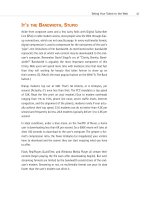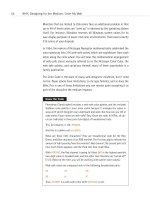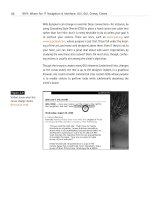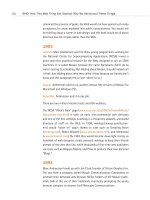Taking Your Talent to the Web- P10 ppsx
Bạn đang xem bản rút gọn của tài liệu. Xem và tải ngay bản đầy đủ của tài liệu tại đây (155.64 KB, 15 trang )
remained the province of geeks, the Web would not have gained such ready
acceptance, let alone exploded into public consciousness. You would not
be thinking about a career in web design, and this book would be all about
delicious low-fat recipes rather than the Web.
1993
January: Marc Andreessen and Eric Bina, young programmers working for
the National Center for Supercomputing Applications (NCSA) invent a
point-and-click graphical browser for the Web, designed to run on UNIX
machines. It is called Mosaic because the name Pantaloons didn’t do as
well in testing. (Just kidding. Not kidding about Mosaic, they did indeed call
it that. Just kidding about why they called it that because we frankly don’t
know and this paragraph felt a little “short” to us.)
August: Andreessen and his co-workers release free versions of Mosaic for
Macintosh and Windows PCs.
December: Andreessen quits his day job.
There are two million Internet hosts and 600 websites.
The NCSA “What’s New” page (www.ncsa.uiuc.edu/SDG/Software/Mosaic/
Docs/whats-new.html) is both an early non-commercial web directory
and one of the first weblogs. A weblog is a frequently updated, annotated
directory of stuff on the Web. In 1998, weblogs (always quietly pres-
ent) would “catch on” again thanks to sites such as Scripting News
(scripting.com), Robot Wisdom (www.robotwisdom.com), and Memepool
(www.memepool.com). By 1999 they would become downright trendy, as
hundreds of web designers create personal weblogs to keep their friends
abreast of the sites they like, while thousands of first-time web publishers
use tools such as Blogger, Manila, and Pitas to produce their own personal
“Blogs.”
1994
Marc Andreessen hooks up with Jim Clark, founder of Silicon Graphics Inc.
The two form a company called Mosaic Communications Corporation to
promote their Netscape web browser. NCSA, holders of the Mosaic trade-
mark, balk at this use of their trademark, eventually prompting the young
browser company to rename itself Netscape Communications.
116
WHO: How This Web Thing Got Started: Why We Mentioned These Things
07 0732 CH04 4/24/01 1:02 PM Page 116
Two graduate students, Jerry Yang and David Filo, form Yahoo! (Yet Another
Hierarchical Officious Oracle), a directory whose purpose is to keep track
of the websites springing up everywhere (www.yahoo.com). The site is
organized somewhat like a library’s card catalog system. Other directories
of lesser quality quickly spring up in imitation.
Wired Magazine’s Hotwired site evangelizes the new medium and pioneers
techniques of web design and web architecture.
Tim Berners-Lee founds the World Wide Web Consortium (W3C), an inter-
national non-profit think tank dedicated to providing a rational roadmap
for the technological advancement of the Web.
People begin designing and producing personal sites because they can.
“Justin’s Links from the Underground” (www.links.com) is one of the fir-
st and most famous personal sites. Glenn Davis launches Cool Site of
the Day (www.coolsiteoftheday.com) to keep track of interesting or funky
content on the rapidly growing Web.
1995
Pushed into public consciousness and acceptance by the coolness of
Netscape’s Navigator graphical browser and by sites such as Cool Site of
the Day, the Web mushrooms. There are now 6.5 million hosts and 100,000
websites.
The Web functions well, but its design potential is sadly underdeveloped.
David Siegel, a typographer and early web designer, publishes “Web Wonk”
(www.dsiegel.com/tips/), an online tutorial offering techniques with which
designers can create pleasing, magazine-like page layouts on the Web by
working around (hacking) the limitations of HTML—the language with
which web pages are created. These techniques seriously conflict with the
purpose of HTML as a simple, structured language for sharing documents.
But they are all designers have to work with at this time. The rift between
the W3C and graphic designers has begun. (In 1996, Siegel publishes the
book, Creating Killer Websites. Though far from the first how-to guide, it
will be one of the first books to treat web design as a serious issue.)
Netscape introduces the tiled background image in Navigator 1.1. Warner
Brothers’ “Batman Forever” site is among the first to make intelligent use
of the feature, hacking it to create the illusion of full-screen images.
117
Taking Your Talent to the Web
07 0732 CH04 4/24/01 1:02 PM Page 117
Batmanforever.com helps prove that the Web has tremendous potential for
anyone wishing to promote an idea, event, or product. There are three mil-
lion web users, and half of them—1.5 million people—view this one site
every week.
Jakob Nielsen, a Ph.D. from Sun Microsystems, begins publishing articles
(www.useit.com) calling for a rational approach to the development of the
Web. Nielsen calls his approach “usability” and claims that it is based on
scientific studies. The rift between designers and usability experts has
begun.
Personal home pages are proliferating.
Yahoo! and other large sites begin running ad banners.
Netscape goes public.
1996
David Siegel creates “High Five” to honor and showcase the
best-designed sites on the Web. (High Five is no longer active, but
archives are available at highfivearchive.com/core/index.html.) He bestows
the first High Five award on his own site. Some consider the gesture arro-
gant, but Siegel doesn’t care; his book is selling like crack. And, to some
extent because of his evangelism, the Web begins attracting greater num-
bers of design professionals and becoming better and better designed as a
result. But this aesthetic boon comes at a cost. Because most of us are
using hacks and workarounds to make our sites more attractive and read-
able, few of us are demanding the creation of robust standards that would
provide better presentational capabilities without breaking the Web’s
structural underpinnings. And since we’re not hollering for better stan-
dards, the W3C isn’t rushing them out the door, and browser makers aren’t
hastening to support them. We will all pay for this later.
“Suck” (suck.com), a brilliantly written daily site created by Joey Anuff and
Carl Steadman, offers sardonic commentary along with a radically flat-
tened hierarchy. Instead of offering a splash page, followed by a contents
page, followed by sectional header pages, and so on (the tedious architec-
ture found in most early sites), Suck slaps its content on the front page
118
WHO: How This Web Thing Got Started: Why We Mentioned These Things
07 0732 CH04 4/24/01 1:02 PM Page 118
where you can’t miss it. Minds reel. The rift between web architects and
graphic designers begins. (Architects think about streamlining and con-
trolling the flow of the user’s experience. Graphic designers think about
reinventing the interface and blowing the user away on every page. Good
web designers struggle to find a balance between these two approaches on
a site-by-site basis.)
Anuff and Steadman will later sell their creation to their employers for
more than lunch money, thus ushering in a period where “content is king,”
whether it’s actually valuable or even read, and where everybody and her
sister wants to be a millionaire. This is not Anuff or Steadman’s fault.
Word.com begins offering intricately designed, well-written content. Like
Suck, Word.com will be purchased later, with mixed results. One mass delu-
sion (“content is dead”) will briefly replace another (“we all get to be mil-
lionaires”).
Netscape introduces JavaScript, a “simple” programming language that
enables web pages to become far more interactive. Web designers begin
stealing JavaScript from each other.
Netscape and Sun announce that Sun’s new object-oriented Java language
will “free” everyone from the “tyranny” of Microsoft’s Windows operating
system. Bill Gates smells the coffee. Microsoft creates Internet Explorer.
The browser wars begin. Over the next four years, Netscape will invent one
way of doing things while Microsoft invents another. Web designers will be
forced to choose which technologies to support—or will support multiple
technologies at considerable cost to their clients. Eventually, most every-
one will realize that the medium can only advance with full support for
common standards.
There are 12.8 million hosts and half a million websites.
1997
Amazon.com begins selling books over the Web. Marketers everywhere
wake up to the promise of e-commerce and begin scrambling to launch e-
commerce companies, add e-commerce capabilities to the offerings of
their existing companies, or just put the letter “e” in front of whatever it is
that they do. There are e-books, e-investments, e-architects, and e-com-
munities. E-nough, already. A brief i-period will follow the e-period.
119
Taking Your Talent to the Web
07 0732 CH04 4/24/01 1:02 PM Page 119
Internet Explorer 3.0 begins to support Cascading Style Sheets (CSS), an
advanced yet simple-to-use design technology created by the W3C.
Netscape Navigator 3.0 does not support CSS but does offer JavaScript
(and JavaScript Style Sheets—a competing technology that nobody ever
adopts). IE3 does not fully support JavaScript. The browser wars escalate,
and the Web becomes still more fragmented.
There are now 19.5 million hosts, one million websites, and 71,618 news-
groups.
1998
There are over 300 million pages on the Web—and 1.5 million new ones
appear online daily.
Internet traffic doubles every 100 days.
Investors become frenzied. Venture capitalists become stupidly wealthy.
Anyone in a suit can raise $5 million by promising to sell anything to any-
body. If we exaggerate, it’s because this is a period of deep delusional
dementia fueled by 80s style greed and 90s style buzzwords. Baby Jesus
weeps.
The growth of e-commerce exceeds its one-year expectation by more than
10,000 percent. The projected growth of business-to-business services on
the Web dwarfs even the growth of e-commerce.
With much money at stake, the browser war’s fragmentation of the Web
becomes intolerable. Developers spend at least 25 percent of their time
working around incompatibilities between Netscape and Microsoft
browsers.
A group of designers, developers, and writers, lead by Glenn Davis
and George Olsen, forms The Web Standards Project (WaSP) at
www.webstandards.org. The group hopes to persuade browser makers to
support common standards so the Web can evolve rationally.
The W3C, which creates most of the standards, lacks police power
to enforce them; in W3C parlance, things such as CSS and HTML 4
are “recommendations.” The WaSP sees these recommendations as an
absolute necessity and will spend the next three years spreading that
gospel by any means necessary.
120
WHO: How This Web Thing Got Started: Why We Mentioned These Things
07 0732 CH04 4/24/01 1:02 PM Page 120
Netscape goes open source, unveiling the secrets of its code in the hopes
that thousands of programmers around the world will join together to cre-
ate a newer, better version of the Netscape browser. The open source proj-
ect for the Netscape Navigator source code is named Mozilla. The
Department of Justice begins an antitrust lawsuit against Microsoft.
1999
America Online (AOL), though partially responsible for the growth and pop-
ularity of the Web, has long been despised by Internet connoisseurs. Many
holding this view are die-hard Netscape users, who see AOL as a propri-
etary service for frightened “newbies” (neophyte Internet users). In a move
that shocks the online world, AOL buys Netscape.
Netscape announces that its upcoming 5.0 browser, being built by
the Mozilla open source project, will fully support the five key stan-
dards demanded by The Web Standards Project (www.webstandards.org
/mission.html). The 5.0 browser never sees the light of day, but in late 2000
the project and Netscape will give birth to Netscape Navigator 6.
Microsoft announces that its upcoming 5.0 browser for the Mac will fully
support two key web standards and offer “90 percent support” for others.
At least 100,000 web-related jobs cannot be filled because of lack of qual-
ified personnel. Populi, the Web Talent Incubator, is launched to solve this
problem. Your humble web author, who appears to enjoy typing the phrase
“your humble web author,” will later help Populi develop a curriculum in
web communication design, which will still later become the basis for the
book you are now reading, which will yet later be unearthed by archeolo-
gists of the thirty-first century, along with a Pepsi bottle.
2000
The year web standards broke, 1
Internet Explorer 5, Macintosh Edition is released in March, offering
near perfect support for HTML 4, CSS-1, and JavaScript
(www.alistapart.com/stories/ie5mac/).
121
Taking Your Talent to the Web
07 0732 CH04 4/24/01 1:02 PM Page 121
The year web standards broke, 2
Netscape 6 is released in the wee hours of November 14. It supports XML,
and the W3C DOM as well as the standards supported by IE5/Mac.
The year web standards broke, 3
Opera 5 (www.opera.com), released in December, supports HTML, CSS, XML,
WML, ECMAScript, and the DOM (www.opera.com/opera5/specs.html).
The year the bubble burst
A number of ill-conceived web businesses fail, causing the usual dire
predictions and market panics. A number of good web businesses
are dragged down along with the unworthy ones. Overbuilt web agencies
lay off staff; other agencies absorb them.
2001
You buy this book. And buy a second copy for a friend. And a third for your
coffee table.
122
WHO: How This Web Thing Got Started: Why We Mentioned These Things
07 0732 CH04 4/24/01 1:02 PM Page 122
chapter 5
The Obligatory Glossary
SEVERAL YEARS BACK, Grey Advertising, Inc. felt it was perceived as a some-
what lackluster agency: large, dependable, and successful at delivering
results, but not exactly cutting-edge in a world of Chiats and Weiden-
Kennedys (the people who have made commercials for Apple and Nike).
Grey wanted to enhance its image, and as companies often do, it brought
in an outside consultant. A depressing sum of money later, the consultant
unveiled this recommendation: make the logo orange. A Grey company
with an orange logo, get it? Unexpected. Cutting edge. Fresh. Or so the con-
sultant argued, and the agency apparently agreed.
The story may be apocryphal, we hasten to add, because Grey has more
lawyers than our publisher. We mention the whole thing because, as if
Internet terminology itself weren’t confusing enough, job nomenclature at
web agencies can be dazzlingly baffling. This is thanks, in part, to consult-
ants who think an orange Grey makes an Apple and “user experience trans-
actional information architect” sounds better than “designer.”
The Web is an insanely great medium. The young industry is exciting
and challenging enough to fulfill you through a dozen lifetimes, but the
business is so new that even people who work in it get confused over
terminology.
08 0732 CH05 4/24/01 11:18 AM Page 123
Some companies have a dozen different titles for designers with slightly
different jobs; other companies slap one title on everybody, and often
enough the title makes little intuitive sense. Orange you Grey we’ve pro-
vided this little chapter to help you navigate the twin minefields of Inter-
net buzzwords and ever-changing job titles? You bet you are. (Our
apologies to Grey Advertising, consultants everywhere, and People for the
Ethical Treatment of Animals, whom we haven’t offended but just felt like
mentioning because it’s a good cause. Besides, if we don’t mention it here,
our cats will claw our eyes out—and they can do it.)
WEB LINGO
Extranet
An extranet is a private network of computers that is created by connect-
ing two or more intranets or by exposing an intranet to specific external
users and no one else. Business-to-business collaboration often uses
extranets.
In English: Extranets are websites that allow Company A to interact with
Company B, and Special Customer C to interact with either or both—pretty
kinky stuff. As a web designer, you may never be called upon to design an
extranet. (If you are, it’s the same thing as designing a website. We’re sorry
to bore you with these tedious distinctions, but that’s our job in a section
like this. We hear the American Movie Classics cable network is hosting an
Alfred Hitchcock retrospective. Maybe you should go watch it until this
chapter blows over.)
On the other hand, the Business-to-Business (B2B) category is one of the
largest growth areas of the Web, so you may find yourself stuck, er, asked
to design extranet sites anyway.
Websites are websites whether they’re designed for the general public or
for private businesses. However, because extranets are business-oriented,
they tend to be more like software and less like magazines or television. In
other words, the challenges are closer to industrial design and technical
design and further from the consumer-oriented design many of us are used
124
WHO: The Obligatory Glossary: Web Lingo
08 0732 CH05 4/24/01 11:18 AM Page 124
to. In still other words, this type of design work is not for everybody, though
some designers adore and excel at it. (Excel is a trademark of Microsoft,
and even though we didn’t use it in that context in the preceding sentence,
their lawyers read everything.)
HTML
Hypertext Markup Language (HTML) is an application of Standard Gener-
alized Markup Language (SGML) and is used to construct hypertext docu-
ments (web pages).
In English: HTML is to web pages what PostScript is to print. But while Post-
Script is a complex programming language, best handled behind the scenes
by software such as Illustrator and Quark XPress, HTML is a simple markup
language best written by human beings. HTML breaks content down into
structural components, much as an outline does.
The simplicity of HTML makes it easy to learn, but that simplicity also can
be limiting. Soon, many sites will be built with more advanced tools, such
as Extensible Markup Language (XML). You need not concern yourself with
that now. Later on in this book we will show you what HTML is, how to use
it correctly, and how to employ it creatively. See Chapter 8, “HTML: The
Building Blocks of Life Itself.”
Hypertext, hyperlinks, and links
For additional information, refer to the section titled, “Website” later in this
chapter.
Internet
The Internet is a worldwide networking infrastructure that connects all
variety of computers together. These connections are made via Internet
protocols including (surprise, surprise) Internet Protocol (IP), Transport
Control Protocol (TCP), and User Datagram Protocol (UDP). IP is used for
addresses, TCP is used to manage sockets (and hence the Web), and UDP is
used to manage Domain Name Servers (DNSs). See Chapter 4, “How This
Web Thing Got Started,” for further explanation.
125
Taking Your Talent to the Web
08 0732 CH05 4/24/01 11:18 AM Page 125
In English: The Internet is to the Web as cable networks are to television
or as phone cables and switching stations are to your Uncle Marvin, who
always phones while you’re away on vacation and then resents you for not
returning his call the very next day. The Internet is a combination of hard-
ware (computers linked together) and software (languages and protocols
that make the whole thing work).
As a web designer, all you need to keep in mind is that you’re not only com-
municating with readers and viewers (“users” if you must), you’re also cre-
ating work that must fit into formats appropriate to Internet technology.
In other words, it’s not your job to manage networks (for instance) as long
as you understand their implications for your work—such as bandwidth and
cross-platform issues. See Chapter 2, “Designing for the Medium.”
Intranet
An intranet is an internal or private networking infrastructure that uses
Internet technologies and tools. Unlike what occurs on the Internet, only
computers on the private physical network can access an intranet.
In English: As a web designer, in addition to creating sites for the public,
you also might be called upon to create intranet sites, which are nothing
more than websites for private companies. For instance, AT&T not only has
websites for the public, it also has thousands of private intranet sites where
its employees can communicate with each other, schedule appointments,
keep track of company policies, and so on.
One other difference worth noting is that when you’re designing an Inter-
net site, it has to be usable by anyone in the world—Netscape, Opera, IE,
and iCab users; 6.0 browser users as well as 2.0 browser users; the blind
and the not-blind; WebTV users and AOL users alike. You get the picture.
On an intranet site, by contrast, all visitors may be using the same web
browser and computing platform, which can simplify some of your design
choices.
Of course, even in such circumstances, it is best to design with open stan-
dards so that your client will not be locked into restrictive choices. For
instance, if you had designed an intranet for a network of Netscape 4 users
126
WHO: The Obligatory Glossary: Web Lingo
08 0732 CH05 4/24/01 11:18 AM Page 126
in 1998, you might have built the entire site using Netscape’s proprietary
LAYERS technology. But with Navigator 6, Netscape stopped supporting
LAYERS in favor of W3C standards. Had you designed specifically for
Netscape’s previous browser, your site would not work when the client
upgraded browsers. Clients dislike that sort of thing, even when they are
the ones who insisted on using a specific technology. Proceed with caution.
Additionally, if all the site’s users are connected via a local network, you
can make bold use of bandwidth-intensive technologies such as streaming
video. When designing for the Web, you need to worry about bandwidth.
Full-screen video is out; smaller video images and heavily compressed
audio might be okay. For more on this fascinating topic, see Dave Linabury’s
“The Ins and Outs of Intranets” at www.alistapart.com/stories/inout/.
JavaScript, ECMAScript, CSS, XML, XHTML, DOM
In English: Additional languages of the Web.
Briefly: JavaScript is a programming language that enables designers or
developers to build dynamic interactivity into their sites, further separat-
ing the Web from print. ECMAScript is a standardized version of JavaScript.
See Chapter 11, “The Joy of JavaScript,” for more particulars on this topic.
Cascading Style Sheets (CSS) is a standard that enables designers to con-
trol online layout and typography. Like HTML, its basics are extremely easy
to learn, though its subtleties elude many designers (as well as many
browsers). See Chapter 10, “Style Sheets for Designers.”
XML is a simplified version of SGML, designed for use on the Net. As of this
writing, it is most often used to deliver database-independent query results
between incompatible software applications. It is not yet universally sup-
ported in web browsers, though XML 1 is fully supported in Netscape 6, and
much of it is supported in IE5 and Opera 5. As a web designer, at least for
the next few years, you will hear about and see XML, but you will not be
called upon to create it—unless you begin marking up your web pages in
Extensible Hypertext Markup Language (XHTML).
127
Taking Your Talent to the Web
08 0732 CH05 4/24/01 11:18 AM Page 127
XHTML is essentially an XML version of HTML that works in most browsers.
It is currently the W3C-recommended markup language for creating sites,
though most sites as of this writing are still created in HTML. The differ-
ences between HTML and XHTML, from the “writing the code” point of
view, are rather small, like Japan, though the implications of XHTML are
rather large, like China.
The Document Object Model (DOM) is a web standard that lets these other
standards “talk to each other” to perform actions. (For more about this, see
Chapter 11.)
With the increasing specialization of the Web, designers are no more
expected to master all these technologies than Rabbis are expected to fry
bacon. Web designers should learn CSS (which is easy), and most learn
enough JavaScript to be dangerous. Developers rather than designers will
likely do the XML and DOM programming as well as most of the heavy-duty
JavaScript/ECMAScript. The longer you work in the field, the more knowl-
edgeable you will become about these standards, but few employers will
expect you to have more than rudimentary awareness of most of this stuff.
Web page
As explained in Chapter 1, “Splash Screen,” a web page is a type of elec-
tronic document, just as a Microsoft Word file or a Photoshop document
is, except that a web page does not require any particular brand of soft-
ware for someone to open and/or use it. And that is the glory of it, broth-
ers and sisters. Developers and designers build web pages in HTML but, as
noted above, they also use stuff besides HTML, which we’ll talk about in
the relevant technical chapters.
Website
A website is a collection of related web pages published on the World Wide
Web.
In English: Click here.
128
WHO: The Obligatory Glossary: Web Lingo
08 0732 CH05 4/24/01 11:18 AM Page 128
Additional terminology
Tech terms will come up like last night’s chili burritos throughout your
career. You can always look up the latest buzzwords (or refresh your mem-
ory about what you have learned) by turning to the Computer Currents
High-Tech Dictionary at www.currents.net/resources/dictionary/.
ROLES AND RESPONSIBILITIES IN THE WEB
WORLD
As a web designer, you will be responsible for creating the look and feel of
websites—or portions thereof. Web designers may create menu bar icons
for sites designed by other designers on their team, or they may create ani-
mated ad banners for sites designed by others. Hey, you’ve read Chapters
2 and 3—you know the deal. (If you don’t, read the next chapter, which
describes the web designer at painful length.) Meanwhile, this seems as
good a place as any to familiarize yourself with some of the other players
on your team.
Web developer/programmer
The web developers on your team will be responsible for the technical
implementation of the site. You might hear them talk about Perl, Java, ASP,
PHP, SSI, XML, ColdFusion, and other technologies. Just smile and nod as if
you get it.
Most sites seamlessly fuse design, content, and interactivity. For that to
happen, teamwork is needed. You don’t have to understand how develop-
ers work their magic any more than developers need to possess design or
writing skills. But thoughtful collaboration and mutual respect for each
other’s disciplines are required to create functionally and aesthetically
superb sites.
Many developers have their roots in UNIX. Some are old hippies; others look
like preteen rejects from the cast of The Matrix. With the frantic need for
qualified personnel, developers also might come from the ranks of tradi-
129
Taking Your Talent to the Web
08 0732 CH05 4/24/01 11:18 AM Page 129
tional information technology (IT) services. Many of these people are won-
derful, but some have a strong bias toward particular technologies and
generally do not approach web development with a “Webby” mindset—by
which we mean a preference for open standards and accessibility.
For instance, IT-trained developers with roots in Microsoft-only shops
sometimes employ technologies that leave Mac, Linux, UNIX, and OS/2
users out in the cold. This is because they don’t know any better; they are
as trapped by their training as that sad little boy who shoots puppies. (We
now make good on our earlier apology to People for the Ethical Treatment
of Animals. You see, this book is really very skillfully woven together in spite
of its strange, dreamlike quality.)
Before accepting a job, be sure to check the company’s offerings using at
least one of these non-Windows operating systems. If the sites fail, the
developers may be biased in favor of proprietary technologies without real-
izing the harmful nature of that predisposition.
Designers who wish their work to reach the broadest possible audience
might want to think twice before accepting a job at a place like that. We’ve
even seen shops where Mac-using designers can’t send email due to Win-
dows-only gateway issues. This is not intended as a slam at Microsoft’s
many fine products, two of which were used in the creation of this book.
It is simply cautionary advice for the job seeker. In our opinion, because
closed systems lock out millions of potential users, serious web developers
prefer open standards.
Project manager
These team members are like technologically savvy account executives.
They help articulate the client’s needs, develop schedules (timelines) and
budgets, and are responsible for keeping the project on track. Just like the
account executives you might have worked with in your traditional design
career, project managers are usually good people with stressful jobs. As you
used to do with account executives, you must employ tact and patience to
negotiate with these folks.
Project managers will often produce things called Gantt Charts, which are
frankly little more than fancy work schedules. Say “thank you” when you
get these. It makes them feel good about themselves.
130
WHO: The Obligatory Glossary: Roles and Responsibilities in the Web World
08 0732 CH05 4/24/01 11:18 AM Page 130









